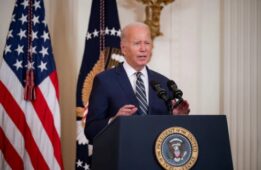Mexico To Pump $30 Billion Into Central America To Halt Migrant Flow usatoday.com
MEXICO CITY — The Mexican government has announced plans to spend $30 billion over the next five years on Central American development, an initiative designed to slow migration from some of the hemisphere’s poorest and most violent countries through Mexico and toward the United States.
Exact details were still pending on how the money would be disbursed, but the Mexican Foreign Ministry said in a tweet Monday that Mexico “will change its migration policies to respond to the needs required in the south of our country and Central America.”
The Mexican announcement comes as more 5,000 Central American migrants traveling in caravans have congregated in Tijuana, where many had hoped to make asylum claims in the United States, but face waiting lists of more than several months.
And it serves as an early test of the relationship between new Mexican President Andrés Manuel López Obrador and President Donald Trump, who has already cut aid to Central America and vowed to halt all foreign aid to the region if the caravan wasn’t stopped.
The two leaders have maintained cordial relations. But as a candidate, López Obrador vowed that he “will not do the dirty work of any foreign government,” a clear swipe at demands Trump was imposing on Mexico to stop the migrant caravan.
It also comes as an early initiative on the migration issue from López Obrador — who, on the campaign trail, responded to questions on migrants transiting Mexico that his country “will not do the dirty work of any foreign government.”
López Obrador hasn’t repeated that pledge since being elected July 1 and has instead proposed a sort of “Marshall Plan” for Central America, which he insists will diminish the need to emigrate in the first place.
“We’re going to guarantee that the rights of migrants in our territory are respected,” he told reporters on Dec. 5. “About how to resolve the problem, we’re putting together a proposal to invest in productive projects and job creation. And, not only that, in work visas as well for Mexican and for the United States.”
López Obrador swept into office on a domestic agenda of curbing corruption, combating poverty and reasserting state influence over economic affairs. But the arrival of so many caravan travelers in Tijuana has thrust migration to the top of the bilateral agenda as he starts his six-year administration — during which time he promises “respect” for the United States and Trump.
López Obrador promises to focus the work of Mexico’s network of consulates in the United States on “defending” the millions of Mexicans living north of the border. But focusing on the thousands of Central Americans transiting the country hasn’t proved a priority for successive Mexican administrations, even as asylum claims accumulate and migrants fleeing violence and poverty increasingly see Mexico as a destination country.
“It’s not part of their project. There is very little to gain politically from it,” said Carlos Bravo Regidor, a professor at the Center for Research and Teaching in Economics. “Nobody wants to deal with it, it’s very hard to find a solution and very easy to screw up.”
Members of the López Obrador administration have negotiated with their U.S. counterparts since before his Dec. 1 inauguration. The Washington Post reported last month that the incoming López Obrador administration and U.S. government had agreed to a plan known as “Remain in Mexico,” in which asylum seekers stay in Mexico while their claims are heard in U.S. courts.
Interior Minister Olga Sánchez Cordero denied any deal, saying Mexico would not serve as a “safe third country,” which means migrants setting foot in Mexico would be unable to seek asylum in the United States and be required to do so in Mexico instead.
Migration observers say “Remain in Mexico” would serve a similar purpose to Mexico becoming a “safe third country.”
“This would be like giving Mexico an excuse to put up a wall and then force people to cross the only way possible, the illegal way,” said Gilberto Martínez Amaya, director of a migrant shelter in Tijuana.






Leave Your Comment